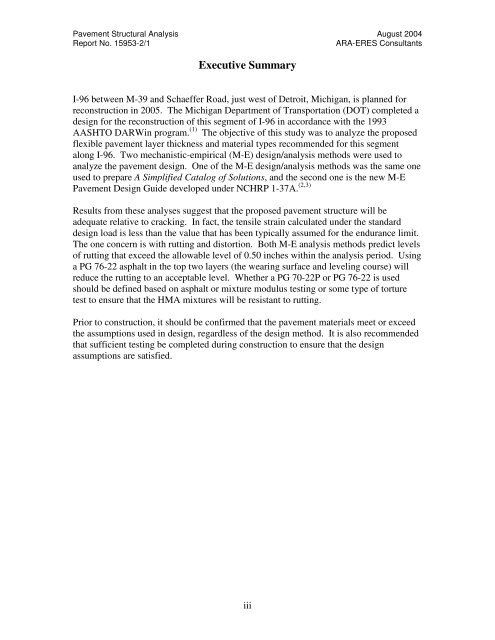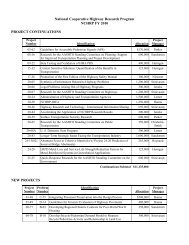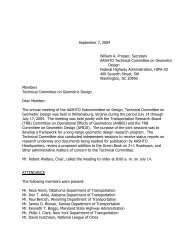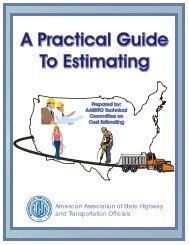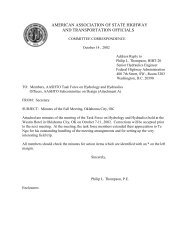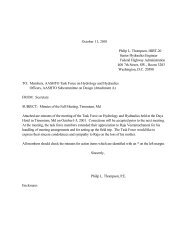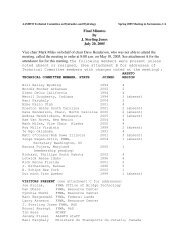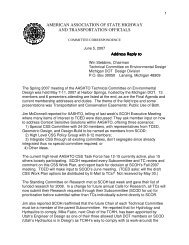Pavement Structural Analysis of the Design Recommendations for ...
Pavement Structural Analysis of the Design Recommendations for ...
Pavement Structural Analysis of the Design Recommendations for ...
Create successful ePaper yourself
Turn your PDF publications into a flip-book with our unique Google optimized e-Paper software.
<strong>Pavement</strong> <strong>Structural</strong> <strong>Analysis</strong> August 2004<br />
Report No. 15953-2/1 ARA-ERES Consultants<br />
Executive Summary<br />
I-96 between M-39 and Schaeffer Road, just west <strong>of</strong> Detroit, Michigan, is planned <strong>for</strong><br />
reconstruction in 2005. The Michigan Department <strong>of</strong> Transportation (DOT) completed a<br />
design <strong>for</strong> <strong>the</strong> reconstruction <strong>of</strong> this segment <strong>of</strong> I-96 in accordance with <strong>the</strong> 1993<br />
AASHTO DARWin program. (1) The objective <strong>of</strong> this study was to analyze <strong>the</strong> proposed<br />
flexible pavement layer thickness and material types recommended <strong>for</strong> this segment<br />
along I-96. Two mechanistic-empirical (M-E) design/analysis methods were used to<br />
analyze <strong>the</strong> pavement design. One <strong>of</strong> <strong>the</strong> M-E design/analysis methods was <strong>the</strong> same one<br />
used to prepare A Simplified Catalog <strong>of</strong> Solutions, and <strong>the</strong> second one is <strong>the</strong> new M-E<br />
<strong>Pavement</strong> <strong>Design</strong> Guide developed under NCHRP 1-37A. (2,3)<br />
Results from <strong>the</strong>se analyses suggest that <strong>the</strong> proposed pavement structure will be<br />
adequate relative to cracking. In fact, <strong>the</strong> tensile strain calculated under <strong>the</strong> standard<br />
design load is less than <strong>the</strong> value that has been typically assumed <strong>for</strong> <strong>the</strong> endurance limit.<br />
The one concern is with rutting and distortion. Both M-E analysis methods predict levels<br />
<strong>of</strong> rutting that exceed <strong>the</strong> allowable level <strong>of</strong> 0.50 inches within <strong>the</strong> analysis period. Using<br />
a PG 76-22 asphalt in <strong>the</strong> top two layers (<strong>the</strong> wearing surface and leveling course) will<br />
reduce <strong>the</strong> rutting to an acceptable level. Whe<strong>the</strong>r a PG 70-22P or PG 76-22 is used<br />
should be defined based on asphalt or mixture modulus testing or some type <strong>of</strong> torture<br />
test to ensure that <strong>the</strong> HMA mixtures will be resistant to rutting.<br />
Prior to construction, it should be confirmed that <strong>the</strong> pavement materials meet or exceed<br />
<strong>the</strong> assumptions used in design, regardless <strong>of</strong> <strong>the</strong> design method. It is also recommended<br />
that sufficient testing be completed during construction to ensure that <strong>the</strong> design<br />
assumptions are satisfied.<br />
iii


